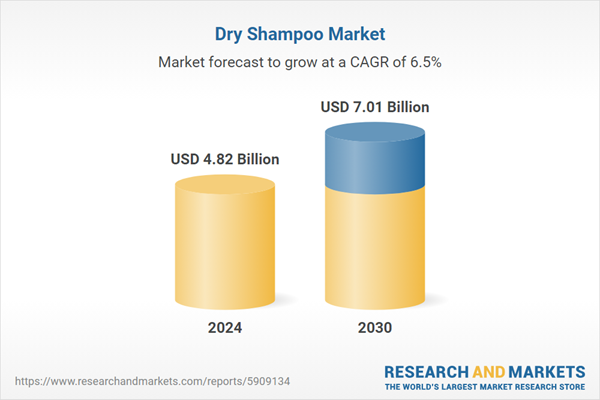Speak directly to the analyst to clarify any post sales queries you may have.
10% Free customizationThis report comes with 10% free customization, enabling you to add data that meets your specific business needs.
Additionally, strong marketing through social media, influencer promotions, and e-commerce platforms continues to enhance product visibility and adoption across varied demographics worldwide. According to data from the U.S. Department of Commerce, e-commerce sales in the United States reached new highs in 2024, with online sales accounting for a record 22.7% of total retail sales. This continues the trend of e-commerce consistently contributing at least 20% of U.S. retail sales since 2020.
Key Market Drivers
Rising Demand for Convenient and Time-Saving Haircare Solutions
One of the strongest drivers of the global dry shampoo market is the increasing demand for quick, convenient, and on-the-go haircare products. Modern consumers, particularly in urban areas, lead fast-paced lifestyles with limited time for traditional hair washing and styling routines. Dry shampoo provides an effective solution by instantly refreshing the hair, absorbing excess oil, and adding volume without the need for water. This convenience appeals not only to working professionals but also to students, travelers, and fitness enthusiasts who require a fast solution between washes. The trend is especially strong among women balancing professional and personal commitments, as well as men who are increasingly investing in grooming products. With growing awareness of scalp and hair health, many consumers now view dry shampoo as a staple in their personal care regimen rather than an occasional substitute.Key Market Challenges
Concerns Over Ingredients and Health Risks
A major challenge facing the dry shampoo market is growing scrutiny over product safety and ingredient transparency. Traditional dry shampoos, particularly aerosol sprays, often contain chemicals such as butane, isobutane, propane, talc, and parabens. These ingredients have raised concerns about scalp irritation, respiratory issues, and potential long-term health effects. In recent years, several brands faced recalls due to the presence of benzene, a known carcinogen, in aerosol dry shampoos.Such recalls not only damage consumer trust but also lead to stricter regulations and compliance costs for manufacturers. Furthermore, health-conscious consumers are increasingly demanding “clean beauty” products free from harmful chemicals, synthetic fragrances, and allergens. Meeting these expectations requires brands to reformulate products with safer, natural ingredients without compromising on performance, which often increases production costs. If not addressed effectively, safety concerns could limit adoption among cautious consumers and hinder overall market growth.
Key Market Trends
Digital Marketing and Influencer-Driven Consumer Engagement
Social media and digital marketing are reshaping how dry shampoos are promoted and embraced worldwide. Influencers, beauty bloggers, and hairstylists regularly share styling tips, tutorials, and reviews, positioning dry shampoo as an essential part of modern haircare routines. Viral TikTok and Instagram content - especially before-and-after results - greatly influence awareness and purchase decisions among younger consumers. Alongside this, direct-to-consumer (DTC) models and e-commerce platforms are extending the reach of both established and emerging brands beyond physical retail.These channels also foster consumer feedback, product customization, and subscription-based services. Notably, around 65% of haircare brands are now adopting AI-driven personalization, using advanced technologies to analyze hair type, scalp condition, and hydration needs. This enables targeted product recommendations and ongoing support for healthier hair. Such digital-first strategies have propelled dry shampoo from a niche product to a mainstream beauty must-have.
Key Market Players
- Procter & Gamble Company
- Kao Corporation
- The Estée Lauder Companies
- Shiseido Company Ltd.
- L’Oreal SA
- Henkel AG & Co. KGaA
- Revlon Inc.
- Church & Dwight Co, Inc.
- Unilever plc
- Coty Inc.
Report Scope:
In this report, the Global Dry Shampoo Market has been segmented into the following categories, in addition to the industry trends which have also been detailed below:Dry Shampoo Market, By Type:
- Spray
- Powder
- Foam
Dry Shampoo Market, By Function:
- Anit-Dandruff
- Color Protection
- Hair Loss Protection
- Daily Care
Dry Shampoo Market, By Distribution Channel:
- Online
- Offline
Dry Shampoo Market, By Region:
- North America
- United States
- Canada
- Mexico
- Europe
- France
- United Kingdom
- Italy
- Germany
- Spain
- Asia-Pacific
- China
- Japan
- India
- South Korea
- Indonesia
- South America
- Argentina
- Colombia
- Brazil
- Middle East & Africa
- South Africa
- Saudi Arabia
- UAE
- Turkey
Competitive Landscape
Company Profiles: Detailed analysis of the major companies present in the Global Dry Shampoo Market.Available Customizations:
With the given market data, the publisher offers customizations according to a company's specific needs. The following customization options are available for the report.Company Information
- Detailed analysis and profiling of additional market players (up to five).
This product will be delivered within 1-3 business days.
Table of Contents
Companies Mentioned
- Procter & Gamble Company
- Kao Corporation
- The Estée Lauder Companies
- Shiseido Company Ltd.
- L’Oreal SA
- Henkel AG & Co. KGaA
- Revlon Inc.
- Church & Dwight Co, Inc.
- Unilever plc
- Coty Inc.
Table Information
| Report Attribute | Details |
|---|---|
| No. of Pages | 180 |
| Published | September 2025 |
| Forecast Period | 2024 - 2030 |
| Estimated Market Value ( USD | $ 4.82 Billion |
| Forecasted Market Value ( USD | $ 7.01 Billion |
| Compound Annual Growth Rate | 6.4% |
| Regions Covered | Global |
| No. of Companies Mentioned | 10 |









